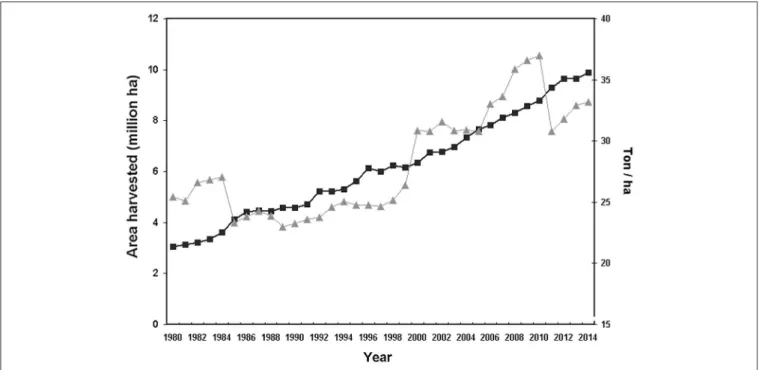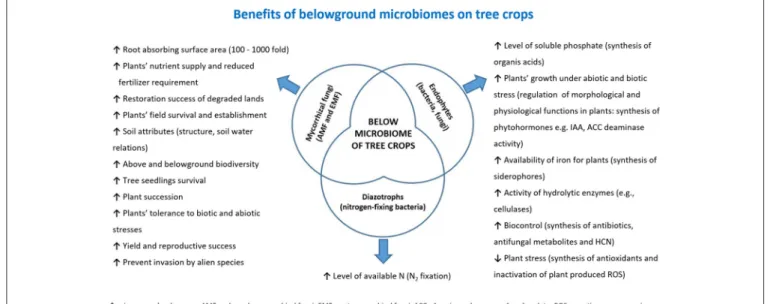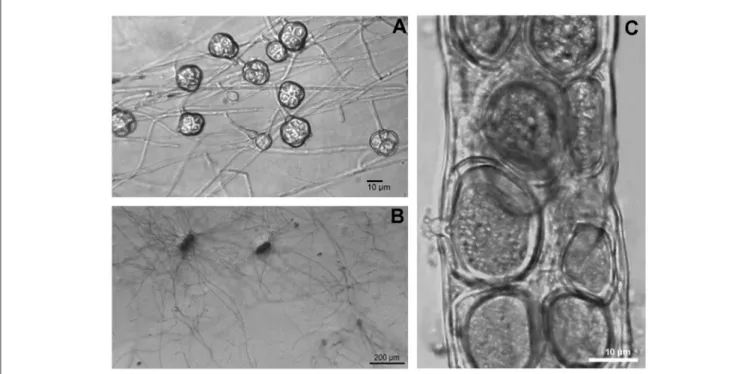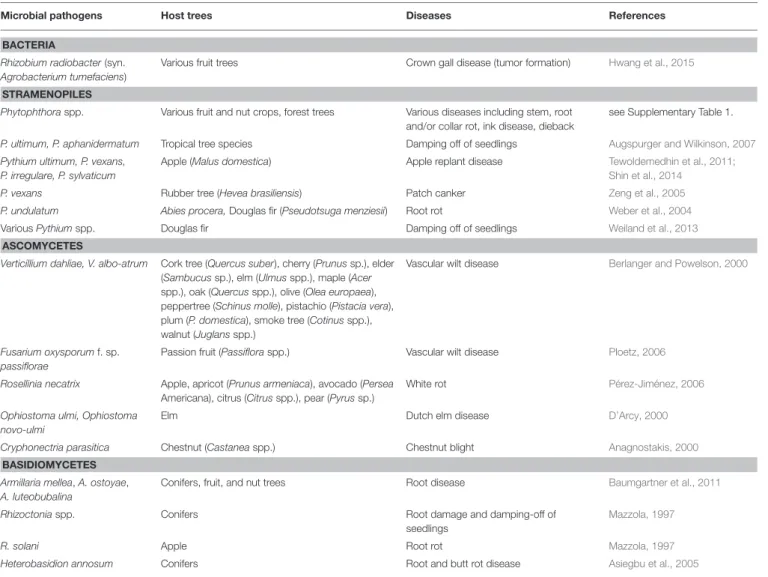Edited by:
Ana Pineda, Netherlands Institute of Ecology (NIOO-KNAW), Netherlands
Reviewed by:
Raquel Campos-Herrera, University of Algarve, Portugal Mika Tapio Tarkka, Helmholtz-Zentrum für Umweltforschung (UFZ), Germany
*Correspondence:
Annamaria Bevivino annamaria.bevivino@enea.it
Specialty section:
This article was submitted to Plant Microbe Interactions, a section of the journal Frontiers in Microbiology
Received:02 January 2018 Accepted:30 April 2018 Published:05 June 2018 Citation:
Mercado-Blanco J, Abrantes I, Barra Caracciolo A, Bevivino A, Ciancio A, Grenni P, Hrynkiewicz K, Kredics L and Proença DN (2018) Belowground Microbiota and the Health of Tree Crops. Front. Microbiol. 9:1006.
doi: 10.3389/fmicb.2018.01006
Belowground Microbiota and the Health of Tree Crops
Jesús Mercado-Blanco1, Isabel Abrantes2, Anna Barra Caracciolo3,
Annamaria Bevivino4*, Aurelio Ciancio5, Paola Grenni3, Katarzyna Hrynkiewicz6, László Kredics7and Diogo N. Proença8
1Department of Crop Protection, Agencia Estatal Consejo Superior de Investigaciones Científicas, Institute for Sustainable Agriculture, Córdoba, Spain,2Department of Life Sciences, Centre for Functional Ecology, University of Coimbra, Coimbra, Portugal,3Water Research Institute (CNR-IRSA), National Research Council, Rome, Italy,4Department for Sustainability of Production and Territorial Systems, Italian National Agency for New Technologies, Energy and Sustainable Economic Development (ENEA), Rome, Italy,5Institute for Sustainable Plant Protection, National Research Council, Bari, Italy,
6Department of Microbiology, Faculty of Biology and Environmental Protection, Nicolaus Copernicus University, Toru ´n, Poland,7Department of Microbiology, Faculty of Science and Informatics, University of Szeged, Szeged, Hungary,8Centre for Mechanical Engineering, Materials and Processes (CEMMPRE) and Department of Life Sciences, University of Coimbra, Coimbra, Portugal
Trees are crucial for sustaining life on our planet. Forests and land devoted to tree crops do not only supply essential edible products to humans and animals, but also additional goods such as paper or wood. They also prevent soil erosion, support microbial, animal, and plant biodiversity, play key roles in nutrient and water cycling processes, and mitigate the effects of climate change acting as carbon dioxide sinks.
Hence, the health of forests and tree cropping systems is of particular significance. In particular, soil/rhizosphere/root-associated microbial communities (known as microbiota) are decisive to sustain the fitness, development, and productivity of trees. These benefits rely on processes aiming to enhance nutrient assimilation efficiency (plant growth promotion) and/or to protect against a number of (a)biotic constraints. Moreover, specific members of the microbial communities associated with perennial tree crops interact with soil invertebrate food webs, underpinning many density regulation mechanisms.
This review discusses belowground microbiota interactions influencing the growth of tree crops. The study of tree-(micro)organism interactions taking place at the belowground level is crucial to understand how they contribute to processes like carbon sequestration, regulation of ecosystem functioning, and nutrient cycling. A comprehensive understanding of the relationship between roots and their associate microbiota can also facilitate the design of novel sustainable approaches for the benefit of these relevant agro-ecosystems. Here, we summarize the methodological approaches to unravel the composition and function of belowground microbiota, the factors influencing their interaction with tree crops, their benefits and harms, with a focus on representative examples of Biological Control Agents (BCA) used against relevant biotic constraints of tree crops. Finally, we add some concluding remarks and suggest future perspectives concerning the microbiota-assisted management strategies to sustain tree crops.
Keywords: tree crops, belowground microbiota, biological control agents, endophytes, mycorrhiza, phytoparasitic nematodes, plant-growth-promoting microorganisms, soil-borne pathogens
INTRODUCTION
Tree crops are fundamental for human nutrition and warrant food security and stability of many farms. The surface covered by tree crops showed a growing trend in the last decade, approaching to a global acreage of 10 Mha for main fruit types with an∼20% increase in productivity during the period 2004–
2014 (FAOSTAT,http://fenix.fao.org/faostat/beta/en/)(Figure 1).
Plants (like trees) as well as the environment (such as soil) consist of complex and diverse assemblage of myriads of microbial species closely associated with their host, either as epiphytes or as endophytes (Trivedi et al., 2016). The association established by a plant and its microbiota (Lederberg, 2006) can be either stable, transient or fluctuating, enduring along the host lifetime determines its development, fitness, and health (Kowalski et al., 2015). The belowground microbiota is mostly comprised of bacteria and fungi belonging to the second trophic level (i.e., decomposers, mutualists, pathogens, parasites, and root-feeders) of the soil food web (Ingham, 1999) (Figure 2). Because of their size, nematodes per definition are not part of the soil microbiota, although they can play important roles in shaping its structure, including not only species belonging to the second trophic level (root-feeder nematodes) but also those ones of the third level (i.e., shredders, predators, grazers), particularly nematodes feeding on fungi and bacteria. Despite their parasitic behavior, phytoparasitic nematodes spend a considerable part of their life- cycle in the soil and represent the first group of plant parasites present in the soil. Therefore, the fraction of microorganisms linked to them can be considered as a specific compnent of the plant-associated microbiota (Vandekerckhove et al., 2000;
Haegeman et al., 2009).
FIGURE 1 |Total world surface (triangles) and yield/hectar (solid squares) of main tree crops (citrus, fresh and tropical, pome and stone fruits) (source FAOSTAT:
http://fenix.fao.org/faostat/beta/en/).
The study of the belowground microbiota has gained attention during the last years. Many studies have investigated soil belowground microbiota focusing on key issues such as the composition, structure, and functioning of these microbial communities and how they are built up and influenced by a range of factors [e.g., changing environment, varying weather/climatic conditions, (diffuse) pollution, anthropogenic actions, plant genotype, plant signals, etc.] [see, for instance (Doornbos et al., 2012; Bakker et al., 2013; Bulgarelli et al., 2013; Mendes et al., 2013; Lakshmanan et al., 2014; Fierer, 2017)]. Structural and functional modifications in the soil/rhizosphere microbiota have a crucial impact on aboveground ecosystems. In the particular case of trees, the trophic interactions established between the host and its associated belowground microbiota could be assumed, at leasta priori, as more durable than that occurring in short- living, herbaceous species. Indeed, due to their perennial, long- living nature, it could be envisaged that belowground microbial communities associated with tree crops may be shaped by more persistent changes than those taking place in annual crops. Trees provide, in a more long-lasting way, an energy flow through photosynthesis, mobilizing nutrients as part of a continuous process leading to their recycling via the organic matter accumulation and its eventual decay. Moreover, due to the absence of annual rotation and lack of soil tillage, perennial tree crops also represent a stable food source not only for building up consortia of beneficial microbial communities but also for many root pathogens or parasites. Direct effects, due to deposition of organic matter and nutrients, could be more constant while indirect effects through agricultural inputs (i.e., application of fertilizers, pesticides, etc., irrigation and soil labor) would potentially work in a similar way as in annual crops.
FIGURE 2 |A simplified food web describing main soil components and their relationships. The nodes are classified by roles as: primary root (dark green), beneficial soil components, organisms or promoters, including soil factors (blue), decomposers (brown), pathogens (orange) and biocontrol agents or antagonists (pale green). Arrows show negative effects(A), such as predation, parasitism, pathogenicity or(B)positive links, such as growth promotion, symbiosis or alimentary provision. Indirect factors such as those related to abundance, competition or other density-dependent effects are not included.
Node labels and sizes are proportional to their connection level (number of edges). Analysis produced with Gephi (Bastian et al., 2009).
Being present on a time scale of years, and having a persistent, deeper root system, the impacts of tree crops (e.g., on nutrients mobilization, organic matter accumulation, parasites, etc.) largely differ from annual crops and thus cannot be considered as comparable. This is well illustrated by the currently-available and powerful metagenomic approaches (Colagiero et al., 2017).
Overall, the events taking place between a tree crop and its associated whole soil microbiota have not been widely investigated.
In this study, we consider a tree crop as a woody, perennial plant with a distinct trunk, such as fruit, nut, and timber trees of economic importance, grown in orchards or in planted forests. Therefore, we exclude from this definition any palm
“tree” species (Arecaceaefamily) as well as any other herbaceous perennial monocots (e.g., Musa spp., Dracaena spp., Poaceae family representatives, etc.) showing arborescent growth, since from both botanical and anatomical point of view they are not true trees. Tree crop ecosystems are of immense importance since they provide a range of products and ecosystem services.
An increased understanding of the links between soil microbiota and trees is certainly helpful for the development of more effective and sustainable tree crop management strategies.
Here, we (i) summarize methodological approaches used to unravel belowground microbial communities, with emphasis on tree crops; (ii) review the composition, distribution, and multitrophic networks of soil and root-associated microbiota, including endophytes, and the way they influence aboveground ecosystems in tree crops; (iii) examine the benefits (productivity, development, health and fitness, stress alleviation) and harms (mainly biotic stresses) for tree crops and woody plantations upon interaction with indigenous and introduced soil-borne (micro)organisms; and (iv) recapitulate strategies implemented for tree crop growth promotion.
METHODOLOGICAL APPROACHES TO UNRAVEL THE COMPOSITION AND FUNCTION OF BELOWGROUND MICROBIOTA
Methods to assess the diversity, structure, and function of microbial communities can be categorized into three main groups, namely conventional, biochemical and molecular.
Here, we summarize the advantages and limitations of main methodological approaches to study the composition and function of rhizosphere microbial communities, with emphasis on tree crops (Table 1).
Conventional and Biochemical Methods
Culture-based methods constitute a good complement to DNA- based approaches. However, they are extremely biased regarding the actual evaluation of microbial genetic diversity since only
<1% of the total number of prokaryotic species present in the environment are culturable. Several improved procedures and media mimic natural environments in terms of nutrients, oxygen gradient, pH, etc. maximizing the cultivable fraction of soil-borne microbial communities (Gravel et al., 2007). In addition, the number of colony-forming units (CFU) is positively correlated with enzymes and respiratory activity. This approach may be applied to characterize the relative abundance of active microorganisms with certain functions or trophic requirements (Blagodatskaya and Kuzyakov, 2013). Even though culture- dependent methods are not ideal for evaluating the actual composition of natural microbial communities when used alone, they are useful for understanding growth habits, development,
TABLE1|Methodstostudybelowgroundmicrobialcommunities. MethodsAdvantagesDisadvantagesCropexamplesReferences CONVENTIONALANDBIOCHEMICAL Growthonculturemedia, Enrichmentcultures,Microorganismisolation,pestcontrolpurposes, etc.;fastandlowcostUsefulexclusivelyforcultivablemicroorganismsMaritimepine(Pinuspinaster),Pinus densifloraandP.thunbergiiIslamandOhga,2013; Proençaetal.,2017a EnzymaticmeasurementsFunctionalactivity;soilqualitybioindicators;early indicationofchangesinsoil;ecosystemdisturbance estimate
Notnecessarilylinkedtorealecological functioningandactivityPoplar(Populussp.)Windingetal.,2005 Communitylevelphysiological profiling(CLPP), sole-carbon-sourceutilization (e.g.,APIandBIOLOG)
Versatileforbacteria,fungiandspecificcarbon sources(BIOLOG);fast,highlyreproducibleand relativelyinexpensive Itreflectspotentialmetabolicdiversityoffast growingmicroorganismsandnotofoverall insitudiversity;sensitivetoinoculumdensity
Grapevine(Vitisspp.),olive,Picea abiesforestSöderbergetal.,2004; Montes-Borregoetal., 2013;Salomonetal.,2014; LladóandBaldrian,2017; Ruano-Rosaetal.,2017 Phospholipidfatty-acidanalysis (PLFA)/TotalEster-linkedFatty Acid(ELFA)/Fattyacidmethyl ester(FAME)analysis
Indicatorofactivemicrobialbiomassopposedto non-livingbiomass;fingerprintofoverallmicrobial communities(Bacteria,Archaea,Fungi)
LimitednumberofmicrobialgroupsidentifiedDiverseHilletal.,2000;Söderberg etal.,2004;Windingetal., 2005;Bastidaetal.,2008; Franciscoetal.,2016 MOLECULAR FluorescentInsituHybridization (FISH)Directidentificationandvisualizationofmicrobial groupsbasedonthehybridizationwithahigh numbercopiesoftheirrRNA;itreflectsmicrobial activityandmakesitpossibletoquantifycell number;DNAextractionfromsoilisnotrequired Cellswithlowactivityarenotidentified;it requiresskilland experienceinthecaseoflowprobepenetration andautofluorescence; informationobtainedis dependentontheavailabilityofdesigned probe(s)
Cactaceae,rosemary(Rosmarinus officinalis)Hilletal.,2000;Barra Caraccioloetal.,2005, 2015;Lopezetal.,2011 Totalmicrobialabundance(DAPI counts);cellviabilityDetectionofallmicrobialcellsindependentlyfrom theirphysiologicalstateOverestimationofcellnumberiftheyarejust deadbutwithanintactDNAPoplar,rosemaryBarraCaraccioloetal., 2015;Anconaetal.,2017 Geneticfingerprintingtechniques (DGGE/TGGE,T-RFLP)
SensitivetovariationinDNAsequences; bandscanbeexcised,clonedandsequencedfor subsequentidentification Multiplebandsforasinglespeciescanbe generatedduetomicro-heterogeneity:canbe usedonlyforshortfragments; complexcommunitiesmayappearsmeared duetoalargenumberofbands; Inconsistencies(geltogelvariation) Citrusspp.,Elsholtziasplendensand Commelinacommunis,pine(Pinus sp.),corktree(Quercussuber)
Hilletal.,2000;Araújoetal., 2002;Kuklinsky-Sobral etal.,2005;Windingetal., 2005;Singhetal.,2007; Shengetal.,2008;Wang etal.,2008;Sunetal., 2010;Bevivinoetal.,2014; Ngetal.,2014;Proença etal.,2017a qPCR,RT-qPCR,dPCRQuantitativeandhighlysensitiveforspecies identificationandfunctionalgenes;easyto implementandcheap;specificamplification confirmedbymeltingcurveanalysis
CanonlybeusedfortargetingofknownDNA sequences;DNAimpuritiesandartifactsmay leadtofalse-positivesorinhibitamplification Poplar,switchgrass(Panicum virgatum)Liangetal.,2014;Caietal., 2015 (Continued)
TABLE1|Continued MethodsAdvantagesDisadvantagesCropexamplesReferences Next-generationsequencing (NGS)Rapidtoassessbiodiversityandabundanceof manyspecies/organizationaltaxonomicunits simultaneously
MassiveamountofsequencingdataofDNA (genomicorPCRamplifiedfragments)orRNA errordistributionwithinreadsofalibrary; insertionsorsubstitutionerrors;relatively expensive; replicationandstatisticalanalysisareessential; computationalintensive;challengingintermsof dataanalysis Maritimepine(Pinuspinaster)Proençaetal.,2017a DNAsequenceanalysisofthe internaltranscribedspacer(ITS) regionformycorrhizalstudies
Fastandaccuratefortheidentificationof mycorrhizalfungiandcharacterizationoftheir distribution.
Relativelyexpensive,especiallyincaseof metagenomicanalysesEctomycorrhizasofpoplar(Populus nigra×maximowiczii)andwillowclone (Salixviminalis)cultivatedasSRF, mycorrhizalfungiofwillow(Salixspp. L.)fromhydrocarbon-contaminated soils,AMFofAcaciagerrardiiunder saltstress Hrynkiewiczetal.,2010; Hassanetal.,2014; Hashemetal.,2016; Afewillustrativeexamplesofherbaceousplantsarealsogiven.
and potential functions of soil and rhizosphere microorganisms (VanInsberghe et al., 2013; Bevivino and Dalmastri, 2017).
Biochemical methods enable the assessment of soil microbiota activities of both the overall microbial community (e.g., dehydrogenase activity) and specific components (e.g., ammonia- oxidizing bacteria). The release of labile compounds, including enzymes, by living roots or lysis of root cells, stimulates microbial activity and growth in a similar way as rhizodeposits (Loeppmann et al., 2016). Consequently, localization of easily available C yields hotspots of microbial abundance and activities, frequently termed as the “rhizosphere effect” (Reinhold-Hurek et al., 2015; Thijs et al., 2016). Extracellular enzyme activities in the rhizosphere are higher compared to root-free soils, similarly to total microbial biomass and activity measured as respiration or growth rates (Allison and Vitousek, 2005; Ancona et al., 2017).
Roots and associated mycorrhizal communities are known as major producers ofβ-glucosidases and acid phosphatases (Conn and Dighton, 2000). Despite soil enzymes being partly of plant origin, microorganisms constitute the main source of enzymes mediating the cycling of major nutrients (C, N, P, and S).
One approach to characterize the soil microbial communities is the Community Level Physiological Profiling (CLPP), in which species are identified based on utilization of different carbon sources with EcoPlateTM (Biolog, Inc.). CLPP yields information on both function and structure of part of a microbial community metabolically active under plate conditions (Garland and Mills, 1991). The BIOLOGR advantages include the identification of physiological profiles of a microbial community as a whole (Stefanowicz, 2006). However, most bacterial cells in natural ecosystems are inactive and the substrates available in BIOLOGR plates are not necessarily relevant from the ecological point of view, and do not reflect the diversity of substrates found in the environment (Konopka et al., 1998). This methodology has been applied to compare functional diversity of communities from rhizosphere and non-rhizosphere soils (Söderberg et al., 2004), from rhizospheres of different plant species (Grayston et al., 1998), and to link microbial functional diversity of olive rhizosphere soil to management systems in commercial orchards (Montes-Borrego et al., 2013). While limitations of this methodology for the characterization of whole communities are well known, it continues to be used in combination with molecular approaches to identify the copiotrophic, fast-growing fraction of the bacterial community of soil environments as those from coniferous forests, where oligotrophic taxa are usually dominant (Lladó and Baldrian, 2017).
Biochemical methods can also be used to assess microbial community structure and to perform a phenotypic fingerprinting of the main groups (Gram-positive and Gram-negative bacteria, fungi, etc.) in the rhizosphere. This is the case of the phospholipid-derived fatty-acid (PLFA) and the total ester- linked fatty-acid (ELFA) methods (Sharma and Buyer, 2015;
Hinojosa et al., 2016). As the fatty-acid side chains are rather unique among the various life forms, these molecules are widely used as taxonomic and phylogenetic biomarkers to describe the structure and size of microbial communities in soil and rhizosphere samples (Debode et al., 2016; Francisco et al., 2016).
Phospholipid fatty-acids are found exclusively in cell membranes
and not in other parts of the cell as storage products. This is important as cell membranes are rapidly degraded and the component PLFA is quickly metabolized following cell death.
Consequently, phospholipids can serve as important indicators of active microbial biomass as opposed to non-living biomass.
These methods are useful for assessing the structure of soil microbial communities and for determining effects of soil disturbances such as cropping practices, pollution, and changes in soil quality. For example, PLFA analysis was successfully used to investigate the impact ofPopulusspp. grown as short rotation coppice (SRC) on the microbial communities of arable soils (Baum et al., 2013).
Molecular Methods
Molecular methods have provided a more-in-depth understanding of the occurrence and phylogenetic diversity of soil microbial communities (Tiedje et al., 1999; Fakruddin and Mannan, 2013). Polymerase chain reaction (PCR)-based approaches are commonly used for phylogenetic assignments.
Small subunit rRNA genes (for instance, the 16S small subunit ribosomal RNA [16S rRNA] for prokaryotic cells) are amplified from soil-extracted nucleic acids. Microbial rRNA gene sequences can then be sequenced and identified using appropriate databases (e.g., NCBI GenBank, EMBL, EzBioCloud, etc.) and compared with those of known microorganisms (Janssen, 2006). Similarly, the identification of soil fungi and fungal symbionts associated with previously selected and characterized mycorrhizas is based on sequence analysis of gene fragments from the large-subunit rRNA (LSU) or their internal transcribed spacer (ITS) regions (Porras-Alfaro et al., 2014).
Taxonomic and phylogenetic affiliation of fungi can be based on widely available databases like the NCBI GenBank or on the stable and reliable platform UNITE, designed for sequence-based identification of ectomycorrhizal asco- and basidiomycetes.
Molecular-based approaches have revealed an extraordinary taxonomical and functional diversity of microorganisms. To study the population structures and dynamics of microbial communities, genetic fingerprinting techniques such as Denaturing Gradient Gel Electrophoresis (DGGE) were developed (Muyzer et al., 1993). Nowadays, DGGE can be used as a first approach to visualize main differences in a given microbial community and subsequently high-throughput sequencing (HTS) can be applied to have a deeper understanding of the microbiota composition (Di Lenola et al., 2017; Proença et al., 2017a). This methodology has been implemented in different fields and it is very common in soil microbiology studies (Bevivino et al., 2014; Ng et al., 2014), or to assess the aboveground microbial structure of trees (e.g., maritime pine, Pinus pinaster Ait.) (Proença et al., 2017a). Other community profiling techniques include temperature gradient gel electrophoresis (TGGE), single-strand conformation polymorphism (SSCP), terminal restriction fragment length polymorphism (T-RFLP), amplified rDNA restriction analysis (ARDRA), and amplified ribosomal intergenic spacer analysis (ARISA) (Anderson and Domsch, 1989; Anderson and Cairney, 2004). These methods can also provide detailed information about community structure in terms of richness,
evenness and composition and permit to identify selected species and functional genes involved in specific processes.
Nevertheless, these qualitative PCR-based methods do not provide information on the gene copy numbers. To achieve that, implementation of qPCR (quantitative PCR) is needed whereas RT-qPCR (reverse transcription qPCR) is informative about the expression of a specific gene (Stella, 2014). However, the phylogenetic characterization of prokaryotic cells based on DNA extraction from soil does not reflect the activity of rhizosphere microbial community, as DNA may also proceed from dead or inactive cells. Likewise, the analysis of biodiversity based on the molecular identification of single ectomycorrhizal roots or arbuscular spores, and the application of cloning for identification of arbuscular mycorrhizal fungi (AMF), have some limitations difficulting a reliable portrait of the microcosm environment condition. Thus, a novel sequence-based method was developed to describe AMF communities, coupling the previously established AMF-specific PCR primers that amplify a c. 1.5-kb long and AMF-specific pSSU-ITS-pLSU fragment with single molecule real-time (SMRT) sequencing (Schlaeppi et al., 2016). Finally, substantial progress has been also made to facilitate the quantitative detection of individual nematode taxa on the basis of small subunit ribosomal DNA-based (SSU-rDNA) monitoring of nematode assemblages (Vervoort et al., 2012). In complex environments, such as soil, the newly developed digital polymerase chain reaction (dPCR) has been recently applied to quantify the absolute concentration of DNA targets or functional genes in soil (Kim et al., 2014; Cavé et al., 2016). This technology represents a promising tool enabling to examine the dynamics of soil microorganisms and to target pathogen-derived nucleic acids in environmental samples (Farkas et al., 2017).
Epifluorescence Microscope-Based Methods
Epifluorescence microscope-based methods do not need DNA extraction from soil, enabling direct visualization of microbial cells/structures under an epifluorescence microscope. The total direct count, cell viability (live/dead) and FluorescenceIn situ Hybridization (FISH) are reliable and commonly used methods.
The total direct count allows assessing microbial abundance through a DNA fluorescent intercalant such as DAPI, which can detect all microbial cells in a rhizosphere sample regardless of their physiological state and metabolic activity (Lew et al., 2010; Barra Caracciolo et al., 2015). Similarly, two fluorescent dyes, SYBRTM Green II and propidium iodide, can be used to discriminate between viable and dead cells (Ancona et al., 2017). Finally, FISH enables phylogeneticin situidentification and quantification of soil and rhizosphere communities at different phylogenetic levels (from domain to species), by using fluorescent labeled rRNA-targeted oligonucleotide probes in single cells. rRNA-targeted probes that occur in a large copy number detect specific sequences of rRNA in single cells. Since only viable and active cells possess a sufficient number of undamaged ribosomes, they act as indicators of the physiological state of cells (Di Lenola et al., 2017). The detection of FISH-stained cells can be hampered by strong soil





